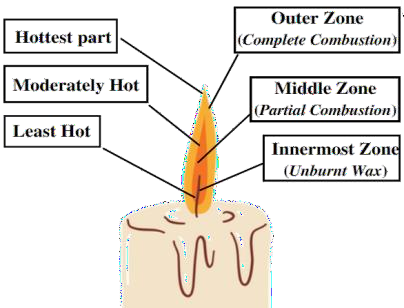Combustion And Flame Class 8 Questions and Answers - Free PDF Download
FAQs on NCERT Solutions For Class 8 Science Chapter 4 Combustion And Flame (2025-26)
1. What are the key conditions required for combustion to occur according to NCERT Solutions for Class 8 Science Chapter 4?
The three essential conditions for combustion are:
- Presence of a fuel (substance to burn)
- Availability of oxygen (usually from air)
- Sufficient heat to reach the ignition temperature.
2. How is a flame formed and what are its different zones as per Class 8 Science Chapter 4?
A flame forms when a fuel undergoes combustion and vaporizes to produce a visible, luminous region. The main zones of a candle flame are:
- Inner zone: Least hot, unburnt wax vapors
- Middle zone: Moderately hot, yellow, partial combustion
- Outermost zone: Hottest, blue, complete combustion
3. What is the calorific value of a fuel and how is it measured in the context of NCERT Solutions for Class 8 Science Chapter 4?
The calorific value of a fuel is the amount of heat produced when one kilogram of fuel is completely burnt. It is measured in kilojoule per kilogram (kJ/kg). A higher calorific value indicates a more efficient fuel.
4. Why is LPG considered a better domestic fuel than wood as per the NCERT Solutions for Combustion and Flame?
LPG (Liquefied Petroleum Gas) is better because:
- It has a higher calorific value
- Produces less smoke and pollution
- Burns completely, reducing wastage
- Does not cause respiratory issues like wood often does
5. How does the use of CNG in vehicles help in reducing pollution in cities?
CNG (Compressed Natural Gas) is a cleaner fuel compared to petrol or diesel. It produces fewer pollutants like unburnt hydrocarbons and emits less smoke, thus helping to reduce air pollution and keeping city environments cleaner.
6. Explain the role of carbon dioxide in fire control according to NCERT Class 8 Science Chapter 4 Solutions.
Carbon dioxide (CO₂) helps extinguish fires by:
- Displacing oxygen near the fire, stopping combustion
- Cooling the burning material as it expands when released
- Acting as a protective blanket over the fire
7. What is meant by ignition temperature, and why is it important for combustion?
Ignition temperature is the minimum temperature at which a substance catches fire. It is crucial because a substance will not ignite and sustain combustion unless this temperature is reached.
8. Compare rapid, spontaneous, and explosive combustion as detailed in the Class 8 Science Chapter 4 NCERT Solutions.
- Rapid combustion: Quick reaction producing heat and light (e.g., burning matchstick)
- Spontaneous combustion: Occurs without external heat (e.g., phosphorous catching fire in air)
- Explosive combustion: Sudden, with sound and heat (e.g., fireworks)
9. Why can't water be used to put out fires caused by electrical equipment or burning oil?
- Electrical fire: Water conducts electricity, increasing electric shock danger.
- Oil fire: Oil floats on water, so fire can spread rather than stop.
10. What is a common misconception about rusting and combustion, and how does Chapter 4 clarify this?
A misconception is that rusting is unrelated to combustion. In fact, rusting is a slow form of combustion where iron reacts with oxygen producing heat, but without flame. Both are oxidation reactions; however, combustion is rapid, rusting is very slow.
11. How can you increase the efficiency of fuel usage as per recommendations in NCERT Solutions for Chapter 4 Science Class 8?
To increase fuel efficiency:
- Use fuels with higher calorific value (like LPG, CNG)
- Ensure complete combustion (adequate air supply)
- Minimize fuel wastage through proper burner design
- Regular maintenance of equipment
12. If a beaker is heated at different flame zones, which will heat fastest and why?
The outermost zone of a flame is the hottest due to complete combustion of fuel. Heating a beaker in this zone will transfer more heat in less time, causing water to boil faster, as shown in the NCERT Class 8 Science Chapter 4 experiments.
13. What are inflammable substances and provide examples from Chapter 4 NCERT Solutions?
Inflammable substances are those that catch fire easily at low ignition temperature. Examples include petrol, alcohol, LPG. They require careful storage due to their high fire risk.
14. How does moisture content affect the combustion of green and dry leaves as per Class 8 Science Chapter 4?
Green leaves have higher moisture, increasing their ignition temperature, so they do not catch fire easily. Dry leaves have little water; they reach ignition temperature quickly, making them burn more readily.
15. What are the main harmful effects of burning fuels, as discussed in NCERT Solutions for Class 8 Science Chapter 4?
The main harmful effects of burning fuels include:
- Air pollution: Emission of smoke and toxic gases
- Global warming: Release of CO₂
- Acid rain: Sulphur and nitrogen oxides mixing with rainwater




















